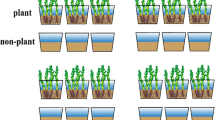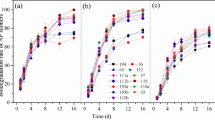Abstract
Graphene may affect fate of organic contaminants due to its strong adsorption properties, which is very crucial for accurately assessing ecological risk of graphene and concurrent contaminants, while the current information remains largely unknown. Here, we firstly explored the adsorption characteristics of sulfonated graphene (SG) for a widespread polychlorinated biphenyl 2,4,4′-trichlorobiphenyl (PCB28) (0.5–100 μg L−1). Subsequently, the influence of SG on the uptake, translocation, and metabolism of PCB28 in maize seedlings was investigated through hydroponic exposure experiment. Adsorption isotherm of PCB28 to SG fitted best with the Langmuir model and the Polanyi-Dubinin-Manes (PDM) model, with the maximum adsorption capacity (Qmax) calculated as around 530 mg kg−1. The presence of SG significantly promoted the maximum accumulation amount of PCB28 in roots by 112%, whereas reduced that in stems and leaves by 32 and 39%, respectively. The translocation factor (TFs) of PCB28 from roots to stems was 26–70% lower for SG exposed seedlings than nonexposed seedlings when the exposure time was longer than 24 h, demonstrating an obvious suppression of SG in the transportation of PCB28 from roots to stems. PCB28 could be metabolized to PCB8 and PCB18 through dechlorination and rearrangement in different parts of maize seedlings. SG significantly increased the accumulation of PCB8 and PCB18 in roots, but decreased that in stems and leaves. These findings might provide new implications for the risk assessment of SG and PCBs in the environment.








Similar content being viewed by others
References
Akhavan O, Ghaderi E (2010) Toxicity of graphene and graphene oxide nanowalls against bacteria. ACS Nano 4(10):5731–5736
Barber JL, Kurt PB, Thomas GO, Kerstiens G, Jones KC (2002) Investigation into the importance of the stomatal pathway in the exchange of PCBs between air and plants. Environ Sci Technol 36(20):4282–4287
Barber JL, Thomas GO, Kerstiens G, Jones KC (2003) Study of plant-air transfer of PCBs from an evergreen shrub: implications for mechanisms and modeling. Environ Sci Technol 37(17):3838–3844
Beless B, Rifai HS, Rodrigues DF (2014) Efficacy of carbonaceous materials for sorbing polychlorinated biphenyls from aqueous solution. Environ Sci Technol 48(17):10372–10379
Chang H, Ren W, Liu H, Teng Y, Li L (2015) Effect of sulfonated graphene on seedling growth and physiological and biochemical indices of wheat. Asian J Ecotoxicol 10:123–128
Chen R, Ratnikova TA, Stone MB, Lin S, Lard M, Huang G, Hudson JS, Ke PC (2010) Differential uptake of carbon nanoparticles by plant and mammalian cells. Small 6(5):612–617
Chen YM, Ren CX, Ouyang SH, Hu XG, Zhou QX (2015) Mitigation in multiple effects of graphene oxide toxicity in zebrafish embryogenesis driven by humic acid. Environ Sci Technol 49(16):10147–10154
Ehsani A, Kowsari E, Ajdari FB, Safari R, Shiri HM (2017) Sulfonated graphene oxide and its nanocomposites with electroactive conjugated polymer as effective pseudocapacitor electrode materials. J Colloid Interface Sci 497:258–265
Hu X, Ouyang S, Mu L, An J, Zhou Q (2015) Effects of graphene oxide and oxidized carbon nanotubes on the cellular division, microstructure, uptake, oxidative stress, and metabolic profiles. Environ Sci Technol 49(18):10825–10833
Jantunen APK, Koelmans AA, Jonker MTO (2010) Modeling polychlorinated biphenyl sorption isotherms for soot and coal. Environ Pollut 158(8):2672–2678
Jonker MTO, Koelmans AA (2001) Polyoxymethylene solid phase extraction as a partitioning method for hydrophobic organic chemicals in sediment and soot. Environ Sci Technol 35(18):3742–3748
Kah M, Zhang X, Jonker MTO, Hofmann T (2011) Measuring and modelling adsorption of PAHs to carbon nanotubes over a six order of magnitude wide concentration range. Environ Sci Technol 45(14):6011–6017
Karamani AA, Douvalis AP, Stalikas CD (2013) Zero-valent iron/iron oxide-oxyhydroxide/graphene as a magnetic sorbent for the enrichment of polychlorinated biphenyls, polyaromatic hydrocarbons and phthalates prior to gas chromatography-mass spectrometry. J Chromatogr A 1271:1–9
Koelmans AA, Meulman B, Meijer T, Jonker MTO (2009) Attenuation of polychlorinated biphenyl sorption to charcoal by humic acids. Environ Sci Technol 43(3):736–742
Larue C, Pinault M, Czarny B, Georgin D, Jaillard D, Bendiab N, Mayne-L'Hermite M, Taran F, Dive V, Carriere M (2012) Quantitative evaluation of multi-walled carbon nanotube uptake in wheat and rapeseed. J Hazard Mater 227:155–163
Li XK, Mu L, Hu XG (2018) Integrating proteomics, metabolomics and typical analysis to investigate the uptake and oxidative stress of graphene oxide and polycyclic aromatic hydrocarbons. Environ Sci Nano 5(1):115–129
Liang SL, Xu S, Zhang D, He JM, Chu MQ (2015) Reproductive toxicity of nanoscale graphene oxide in male mice. Nanotoxicology 9(1):92–105
Liu J, Schnoor JL (2008) Uptake and translocation of lesser-chlorinated polychlorinated biphenyls (PCBs) in whole hybrid poplar plants after hydroponic exposure. Chemosphere 73(10):1608–1616
Liu Y, Wang X, Wang J, Nie Y, Du H, Dai H, Wang J, Wang M, Chen S, Hei TK, Deng Z, Wu L, Xu A (2016) Graphene oxide attenuates the cytotoxicity and mutagenicity of PCB52 via activation of genuine autophagy. Environ Sci Technol 50(6):3154–3164
Pei Z, Li L, Sun L, Zhang S, Shan XQ, Yang S, Wen B (2013) Adsorption characteristics of 1,2,4-trichlorobenzene, 2,4,6-trichlorophenol, 2-naphthol and naphthalene on graphene and graphene oxide. Carbon 51:156–163
Qi Z, Hou L, Zhu D, Ji R, Chen W (2014) Enhanced transport of phenanthrene and 1-naphthol by colloidal graphene oxide nanoparticles in saturated soil. Environ Sci Technol 48:10136–10144
Ren WJ, Ren GD, Teng Y, Li ZG, Li LN (2015) Time-dependent effect of graphene on the structure, abundance, and function of the soil bacterial community. J Hazard Mater 297:286–294
Ren WJ, Chang HW, Teng Y (2016) Sulfonated graphene-induced hormesis is mediated through oxidative stress in the roots of maize seedlings. Sci Total Environ 572:926–934
Sanchis J, Olmos M, Vincent P, Farre M, Barcelo D (2016) New insights on the influence of organic co-contaminants on the aquatic toxicology of carbon nanomaterials. Environ Sci Technol 50(2):961–969
Serag MF, Kaji N, Tokeshi M, Baba Y (2012) Introducing carbon nanotubes into living walled plant cells through cellulase-induced nanoholes. RSC Adv 2(2):398–400
Shen Y, Chen B (2015) Sulfonated graphene nanosheets as a superb adsorbent for various environmental pollutants in water. Environ Sci Technol 49(12):7364–7372
Sporring S, Bowadt S, Svensmark B, Bjorklund E (2005) Comprehensive comparison of classic Soxhlet extraction with Soxtec extraction, ultrasonication extraction, supercritical fluid extraction, microwave assisted extraction and accelerated solvent extraction for the determination of polychlorinated biphenyls in soil. J Chromatogr A 1090:1–9
Ssebugere P, Sillanpaa M, Kiremire BT, Kasozi GN, Wang P, Sojinu SO, Otieno PO, Zhu NL, Zhu CF, Zhang HD, Shang HT, Ren DW, Li YM, Zhang QH, Jiang GB (2014) Polychlorinated biphenyls and hexachlorocyclohexanes in sediments and fish species from the Napoleon Gulf of Lake Victoria, Uganda. Sci Total Environ 481:55–60
Steinlin C, Bogdal C, Scheringer M, Pavlova PA, Schwikowski M, Schmid P, Hungerbuehler K (2014) Polychlorinated biphenyls in glaciers. 2. Model results of deposition and incorporation processes. Environ Sci Technol 48(14):7849–7857
Thombal RS, Jadhav VH (2016) Sulfonated graphene oxide as highly efficient catalyst for glycosylation. J Carbohydr Chem 35:57–68
Velzeboer I, Kwadijk C, Koelmans AA (2014) Strong sorption of PCBs to nanoplastics, microplastics, carbon nanotubes, and fullerenes. Environ Sci Technol 48(9):4869–4876
Wang XL, Tao S, Xing BS (2009) Sorption and competition of aromatic compounds and humic acid on multiwalled carbon nanotubes. Environ Sci Technol 43(16):6214–6219
Wang S, Zhang S, Huang H, Zhao M, Lv J (2011) Uptake, translocation and metabolism of polybrominated diphenyl ethers (PBDEs) and polychlorinated biphenyls (PCBs) in maize (Zea mays L.). Chemosphere 85(3):379–385
Wang SB, Sun HQ, Ang HM, Tade MO (2013) Adsorptive remediation of environmental pollutants using novel graphene-based nanomaterials. Chem Eng J 226:336–347
Wang J, Chen Z, Chen B (2014) Adsorption of polycyclic aromatic hydrocarbons by graphene and graphene oxide nanosheets. Environ Sci Technol 48(9):4817–4825
Wang J, Chen BL, Xing BS (2016) Wrinkles and folds of activated graphene nanosheets as fast and efficient adsorptive sites for hydrophobic organic contaminants. Environ Sci Technol 50(7):3798–3808
Wild E, Jones KC (2009) Novel method for the direct visualization of in vivo nanomaterials and chemical interactions in plants. Environ Sci Technol 43(14):5290–5294
Yu JG, Yu LY, Yang H, Liu Q, Chen XH, Jiang XY, Chen XQ, Jiao FP (2015) Graphene nanosheets as novel adsorbents in adsorption, preconcentration and removal of gases, organic compounds and metal ions. Sci Total Environ 502:70–79
Zeng S, Gan N, Weideman-Mera R, Cao Y, Li T, Sang W (2013) Enrichment of polychlorinated biphenyl 28 from aqueous solutions using Fe3O4 grafted graphene oxide. Chem Eng J 218:108–115
Zeng LX, Li N, Shao DD, Kang Y, Zhang QY, Lu P, Li LS, Luo JW, Guo XM (2014) Concentrations, sources, and risk assessment of polychlorinated biphenyls in vegetables near a waste-incinerator site, South China. Arch Environ Contam Toxicol 67(1):78–86
Zhai G, Gutowski SM, Walters KS, Yan B, Schnoor JL (2015) Charge, size, and cellular selectivity for multiwall carbon nanotubes by maize and soybean. Environ Sci Technol 49(12):7380–7390
Zhang L, Wang L, Zhang P, Kan AT, Chen W, Tomson MB (2011) Facilitated transport of 2,2′,5,5′-polychlorinated biphenyl and phenanthrene by fullerene nanoparticles through sandy soil columns. Environ Sci Technol 45(4):1341–1348
Zhao GX, Li JX, Wang XK (2011) Kinetic and thermodynamic study of 1-naphthol adsorption from aqueous solution to sulfonated graphene nanosheets. Chem Eng J 173:185–190
Zhao SQ, Wang QQ, Zhao YL, Rui Q, Wang DY (2015) Toxicity and translocation of graphene oxide in Arabidopsis thaliana. Environ Toxicol Pharmacol 39(1):145–156
Zhu S, Liu YG, Liu SB, Zeng GM, Jiang LH, Tan XF, Zhou L, Zeng W, Li TT, Yang CP (2017) Adsorption of emerging contaminant metformin using graphene oxide. Chemosphere 179:20–28
Funding
This work was financially supported by the National Key Research and Development Program of China (2017YFA0207001), the National Natural Science Foundation of China (Grant No. 41401565), the Natural Science Foundation of Jiangsu Province (No. BK20161616), and the Outstanding Youth Fund of Jiangsu Province (No. BK20150049).
Author information
Authors and Affiliations
Corresponding author
Additional information
Responsible editor: Yi-ping Chen
Rights and permissions
About this article
Cite this article
Ren, W., Chang, H., Wang, Y. et al. Effect of sulfonated graphene on uptake, translocation, and metabolism of 2,4,4′-trichlorobiphenyl in maize seedlings. Environ Sci Pollut Res 25, 20084–20096 (2018). https://doi.org/10.1007/s11356-018-2203-z
Received:
Accepted:
Published:
Issue Date:
DOI: https://doi.org/10.1007/s11356-018-2203-z




